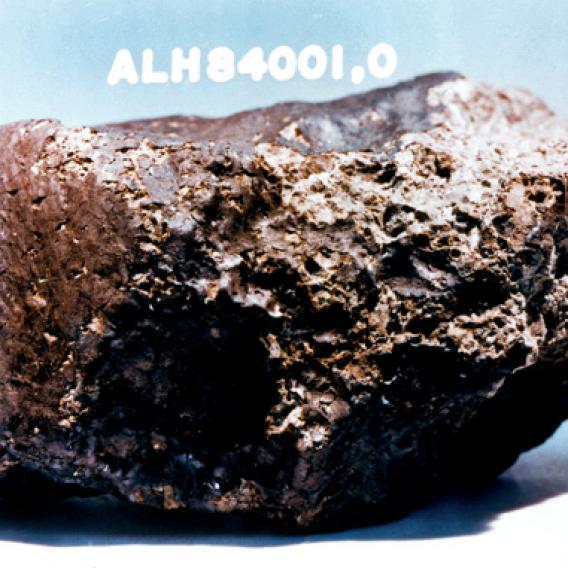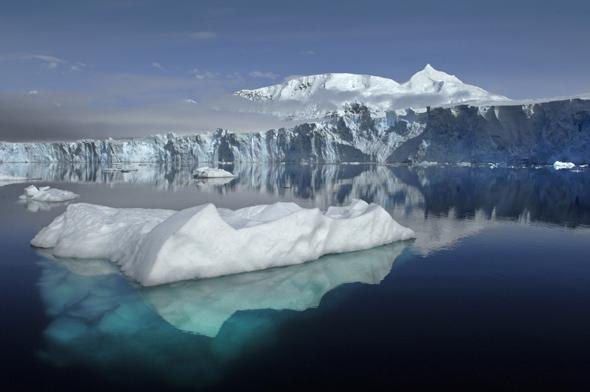We’ve been to the moon and just about everywhere on Earth. So what’s left to discover? In September, Future Tense is publishing a series of articles in response to the question, “Is exploration dead?” Read more about modern-day exploration of the sea, space, land, and more unexpected areas.
Traditionally, when we think of exploring the solar system, we conjure up images of spacecraft that cost billions of dollars and traverse millions of miles to reach other worlds. We almost never stop to think that pieces of these other worlds may actually traverse millions of miles to reach us free of cost.
Fragments of asteroidal and planetary bodies in our solar system have been falling to Earth throughout the course of its 4.6 billion-year history. While there is some loss of this material from frictional heating in the atmosphere as the fragments fall to Earth, larger pieces do make it to the surface as meteorites (not to be confused with meteors, which represent only the light and sound phenomenon associated with the fall of a space rock through the Earth’s atmosphere). Scientists have used these pieces to push back the limits of our understanding of how and when our solar system and the planets in it were formed.
Meteorites fall everywhere on Earth with equal probability, but there are places where they are more easily found because the geology and the environmental conditions allow these fallen rocks to be preserved for up to millions of years. In fact, some of the best meteorite-hunting grounds are in the cold deserts of Antarctica. The cold and dry conditions keep these rocks from space from being weathered and eroded away. Other factors unique to Antarctica are in play, too, and they serve to actively concentrate meteorites in certain areas called “stranding surfaces.” These surfaces are typically found in ice fields near the Transantarctic Mountains. Here, the movement of the ice sheets toward the Antarctic coastlines pushes them up against the mountains. At the same time, the high-speed, gravitationally driven Katabatic winds ablate away the surface of this ice to expose meteorites that had previously fallen on the ice sheets and been carried along with them. What results is a treasure trove of meteorites: Often dozens or even hundreds can be found in an area the size of a football field. There are no other places on Earth where such concentrations of relatively well-preserved meteorites have been found. We have discovered that the southernmost continent is a uniquely excellent place to hunt for space rocks. And this discovery was made rather serendipitously.
In 1973, William Cassidy, a professor of geology and planetary science at the University of Pittsburgh, was attending a conference and happened to hear a talk about meteorites that a team of Japanese glaciologists had found in the Antarctic during a field trip in 1969. The scientists had apparently uncovered nine meteorites in a relatively small area—50 square kilometers. This would not have been terribly surprising if all these rocks had been of the same kind, which would have suggested that they came from a single meteorite fall. However, these nine meteorites represented five different types.
Something clicked for Cassidy: This meant that there was some sort of meteorite concentration mechanism operating in such areas in Antarctica. It then took him a few years to convince the National Science Foundation that it was worth funding an expedition to the white continent to hunt and collect meteorites, but he eventually managed to do it. This is how the U.S. Antarctic Search for Meteorites, or ANSMET, program came into being in 1976, and it has since been hugely successful. In the last 37 years, more than 20,000 meteorite specimens have been collected in Antarctica by the ANSMET program. This represents many more meteorites than were ever recovered throughout the world in the 500 years prior. Parallel collection efforts by the Japanese and Europeans inspired by ANSMET have similarly resulted in the recovery of thousands more meteorites. The amazing thing is that total cost of this entire enterprise of collecting meteorites in Antarctica, by the combined efforts of the Americans, Japanese and Europeans for well over three decades, has been less than the cost of a NASA Discovery mission—a class of mission described by former NASA Administrator Daniel Goldin as a “faster, better, cheaper” way of exploring the solar system.

Photo by Education Images/UIG via Getty Images
The contribution of the Antarctic meteorite collection effort to planetary science, and to scientific knowledge in general, cannot be overstated. The new and unique meteorite samples collected from this effort over the years have literally allowed scientists working in laboratories here on Earth to explore the far reaches of the solar system. Indeed, these meteorites represent fragments of other worlds that are unlikely to be visited by any spacecraft in the near future, much less by a sample return mission that might bring back materials from them.
For example, one of the most significant developments enabled by the Antarctic meteorite collection effort has been the recognition that although the majority of meteorites originated on asteroids, a small fraction have originated on Mars and the moon, thus providing us with the ability to study the origin and evolution of these planetary bodies. The first meteorites for which Martian and lunar origins were established beyond reasonable doubt (named EETA 79001 and ALHA 81005, respectively) were recovered in Antarctica within the first five years of the ANSMET program. Given that it could be many years before we are able to return to the moon or to get a sample back from Mars, the Antarctic has taken on a special significance as the potential source of new and interesting planetary materials for scientific investigations.
On a more personal note, I will vouch for the fact that a trip to the ice to collect precious fragments of other worlds can be exhilirating and perhaps even life-changing. It is the knowledge that one is doing one’s part in contributing to the grand scientific enterprise. It is being immersed every single day, for weeks at a time, in the astounding beauty of a uniquely majestic place on our Earth where not too many humans have ever set foot. It is knowing that the meteorites being collected are each a piece of another place in our solar system where no human may ever set foot.
More from Slate’s series on the future of exploration: Is the ocean the real final frontier, or is manned sea exploration dead? Why are the best meteorites found in Antarctica? Can humans reproduce on interstellar journeys? Why are we still looking for Atlantis? Why do we celebrate the discovery of new species but keep destroying their homes? Who will win the race to claim the melting Arctic—conservationists or profiteers? Why don’t travelers ditch Yelp and Google in favor of wandering? What can exploring Google’s Ngram Viewer teach us about history? How did a 1961 conference jump-start the serious search for extraterrestrial life? Why are liminal spaces—where urban areas meet nature—so beautiful?
The author participated in the 1992-1993 and the 2012-2013 field seasons of the ANSMET program, which is operated through Case Western Reserve University with support from NSF, NASA, and the Smithsonian Institution. This article arises from Future Tense, a collaboration among Arizona State University, the New America Foundation, and Slate. Future Tense explores the ways emerging technologies affect society, policy, and culture. To read more, visit the Future Tense blog and the Future Tense home page. You can also follow us on Twitter.
